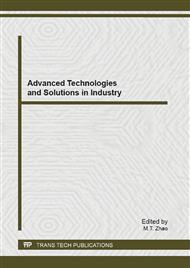[1]
Ikesue A, Kinoshita T, Kamata K, Yoshida K, Fabrication and optical properties of high-performance polycrystalline Nd: YAG ceramics for solid-state lasers, J Am Ceram Soc. 78.
DOI: 10.1002/chin.199535309
Google Scholar
[4]
(1995)1033-1040.
Google Scholar
[2]
Jiang LI, Yusong WU, Yubai PAN et al, Solid-state-reaction fabrication and properties of a high-doping Nd: YAG transparent laser ceramic, Front. Chem. Eng. China 2 (2008) 248-252.
DOI: 10.1007/s11705-008-0048-6
Google Scholar
[3]
Zhihong Sun, Duorong Yuan, Haoqiang Li et al, Synthesis of yttrium aluminum garnet (YAG) by a new sol-gel method, Journal of Alloys and Compounds 379 (2004) L1-L3.
DOI: 10.1016/j.jallcom.2004.02.030
Google Scholar
[4]
Jahangir Hasani Barbaran, Morteza Farmahini Farahani, Fereshteh Hajiesmaeilbaigi, Synthesis of highly doped Nd: YAG powder by SOL-GEL method, Semiconductor Physics, Quantum Electronics & Optoelectronics, 8.
Google Scholar
[1]
2005) 87-89.
Google Scholar
[5]
L. D. Wang, L. G. Zhang, Y. Fan, J. S. Luo, P. P. Zhang, and L. N. An, Synthesis of Nd/Si Codoped YAG Powders Via a Solvothermal Method, J. Am. Ceram. Soc. 89.
DOI: 10.1111/j.1551-2916.2006.01261.x
Google Scholar
[11]
(2006) 3570-3572.
Google Scholar
[6]
J. W. G. A. Vrolijk, J. W. M. M. Willems, and R. Metselaar, Co-precipitation of Yttrium and Aluminum Hydroxides for Preparation of Yttrium Aluminum Garnet, J. Eur. Ceram. Soc. 6 (1990) 47-51.
DOI: 10.1016/0955-2219(90)90034-d
Google Scholar
[7]
P. Palmero, C. Esnouf, L. Montanaro, and G. Fantozzi, Influence of the Co-Precipitation Temperature on Phase Evolution in Yttrium-Aluminium Oxide Materials, J. Eur. Ceram. Soc. 25 (2005) 1565-1573.
DOI: 10.1016/j.jeurceramsoc.2004.05.027
Google Scholar
[8]
J. G. Li, T. Ikegami, J. H. Lee, T. Mori, and Y. Yajima, Co-precipitation Synthesis and Sintering of Yttrium Aluminum Garnet (YAG) Powders: The Effect of Precipitant, J. Eur. Ceram. Soc. 20 (2000) 2395-2405.
DOI: 10.1016/s0955-2219(00)00116-3
Google Scholar
[9]
Y. Rabinovitch, C. Bogicevic, F. Karolak, and et al, Freeze-dried nanometric neodymium-doped YAG powders for transparent ceramics, Journal of Materials Processing Technology. 99 (2008) 314-320.
DOI: 10.1016/j.jmatprotec.2007.08.022
Google Scholar
[10]
Hua Gong, Ding-yuan Tang, and Hui Huang, Agglomeration control of Nd: YAG nanoparticles via Freeze drying for transparent Nd: YAG ceramics, J. Am. Ceram. Soc. 92.
Google Scholar
[4]
( 2009) 812-817.
Google Scholar
[11]
M. B. KAKADE, S. RAMANATHAN, S. K. ROY,Synthesis of YAG powder by aluminum nitrate yttrium nitrate glycine reaction,Journal of Materials Science Letters 21(2002) 927- 929.
Google Scholar
[12]
LI Chang-qing, ZUO Hong-bo, ZHANG Ming-fu, and et al, Fabrication of transparent YAG ceramics by traditional solid-state-reaction method. Trans. Nonferrous Met. Soc. China 17(2007) 148-153.
DOI: 10.1016/s1003-6326(07)60064-8
Google Scholar


